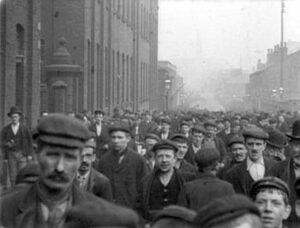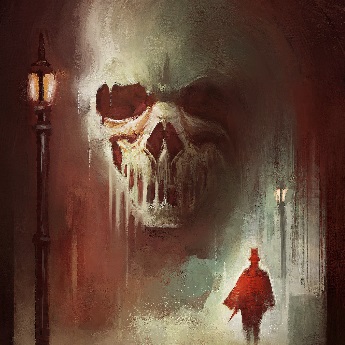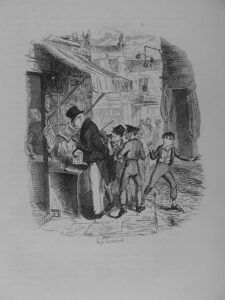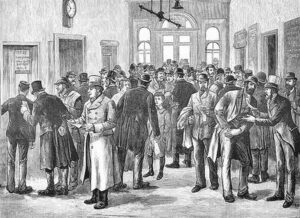What was Crime Like in Victorian London?
Date post added: 16th April 2024
When you picture the Victorian London we know from classic novels, period dramas, films and plays, it’s generally pretty gritty. The characters that spring to mind are the legendary Jack the Ripper who carried out gruesome murders in the East End of London. Then there’s the likes of Bill Sikes, the Dickensian robber and murderer, and his young pickpocket protege, The Artful Dodger.
Nineteenth century London, and indeed much of England and Britain, seems a rather fearful place to be. But was Victorian England any worse than it is now?
Queen Victoria came to the throne in 1837 and the Victorian period began. This era of British history is one of change, of reform and progress. But it’s also a time of dire poverty, slums, workhouses and huge divides between the working class, middle class and upper class sections of society.
Here, we’ll explore crime and punishment in Victorian times, sharing a slice of social history and some of the most famous true (and fictional) crime stories of the time.
A quick social history of Victorian London
Victorian Britain was dominated by the Industrial Revolution. Whilst that brought huge growth in global trade, there was also untold squalor, poverty, daily filth, stench and sickness for many.
The sprawling metropolis that was London was a tale of two cities in the 19th century. The fabulously wealthy, upper-class West End and the gritty and grisly East End of London. Whilst the West End girls took strolls through Mayfair and attended high society balls, working-class life in the East End was a lot less cheery.
It was a time of grinding poverty, crime and disease. Death was ever-present. Women were subjected to regular domestic beatings, were driven into prostitution, became cheap labour in sweatshops or, if they were exceptionally lucky, overworked as domestic servants in middle-class households. Men and women experienced life in slums, workhouses and the sewers. It was a far cry from aristocratic life up west.
True crime and fictional stories
Probably our most common reference points for this era are the (in)famous characters and their stories. Think the horrific true crime story of Jack the Ripper. Then there’s the fictional (yet almost certainly based on real life experiences), Dickensian characters in Oliver Twist.
Our Jack the Ripper tour is a perennial favourite. The grisly story of the Whitechapel (and other) murders continues to fascinate and repulse people centuries later. Jack terrorised the streets and alleyways of Whitechapel and Spitalfields, over the autumn of 1888. The Jack the Ripper Tour is dedicated to the Ripper’s victims Mary Ann “Polly” Nichols, Annie Chapman, Elizabeth Stride, Catherine Eddowes and Mary Jane Kelly (but there may well have been more). But why wasn’t the Ripper caught? His murders spanned the beats of two London police forces – City of London Police and Scotland Yard. The conflict between these arms of the law and their leading personalities made it far easier for the Ripper to slip through the cracks.
Charles Dickens was exceptionally good at bringing this era into vivid, real life. Other writers of the time, like Henry Mayhew, often wrote like intrepid explorers observing an exotic, foreign species when they described the slums and ‘rookeries’ of the poor at that time. But Dickens had had his own brush with poverty, prison life and workhouses, and he used these insights in his descriptive 19th-century novels. Read Oliver Twist and you’ll enter an underworld of juvenile crime, pickpockets, robbers, prostitutes and ultimately, murderers. “You’ve gotta pick a pocket or two,” was the daily reality for many poverty-stricken petty criminals of that time. Our Dickens London guided walk explores this further with fascinating insights into the social history of the time and amusing stories.
What were the most common crimes committed in Victorian London?
Violent crime counted for only 10% of all crime in Victorian London. But many violent crimes including murders weren’t recorded, particularly those of working class victims. It’s amazing how many working-class bodies could be swept under the carpet in Victorian Britain.
Undoubtedly, there was a vast amount of violent crime that went on behind closed doors. And that’s where crimes of domestic violence stayed in Victorian Britain. It was usual for domestic crimes and infanticide to remain unreported.
Petty crimes accounted for around 75% of the total. And pickpocketing was right at the top of that list. A step up from pickpocketing was garrotting – a kind of street robbery or mugging where the victim would be partially strangled. There was huge fear around garrotting (even though it was relatively rare) and the media fanned those flames. This furore led to Parliament passing The Garrotters Act in 1863 which reintroduced floggings as the punishment for violent robbery.
What was the Victorian view of crime and punishment and the police force?
Early in the 19th century, hanging was the capital punishment of choice for serious crimes. It was a popular event that drew thousands of spectators. By the middle of the century, hanging was only used on murderers, which reduced the numbers. Other serious criminals were sentenced to hard labour and/or transportation to Australia.
During this time, a new police force was formed. In 1829, the Metropolitan Police Force and The Detective Force in 1842. This evolved further in 1856 with the Police Act which saw the start of the Modern Police Service in England and Wales.
By the mid-19th century, Australia was pushing back on the process of transportation. They didn’t want to be a dumping ground for British criminals. So a revamp of the British prison system was needed. Old-style, overcrowded, mixed gaols were transformed into new model prisons. Prisoners could expect water, clothes and separate facilities for men and women. An element of rehabilitation was introduced. This was progress.
Whilst many of these aspects seem a far cry from modern Britain. There’s one thing that remains the same – the media and public commentary can have a huge impact on perception. We mentioned above that the media led the charge to punish violent robbers harshly (even though relatively low numbers of these crimes occurred). The resulting moral outcry led to Parliamentary change (the 1863 Garrotters Act). It’s a shame the media didn’t raise the same levels of attention to the domestic crimes that police tended to turn a blind eye to.
At the time of Jack the Ripper, there was generally strong support for the police force investigating the crimes. The press whipped up a nationwide panic over the East End crimes, aware that sensational murders sell papers. And along came W.T. Stead, the Editor of the Pall Mall Gazette. A champion of the working classes with a mistrust and dislike of the police force, Stead bad-mouthed them and his voice gained traction. However, many members of the public tried to help the police with their murder investigation – either out of a desire to support the Metropolitan Police Force or a macabre interest in the Ripper.
Like today, the police force had its supporters and detractors. Like today, London wasn’t an entirely safe place to walk home alone. Unlike today, we no longer gather around the gallows to see a criminal hang. Crime and punishment in Victorian times were particularly brutal. Life itself was exceptionally rough for large swathes of society.
Our expert guides bring Victorian London to life
Our ever-popular Jack The Ripper walking tour is a journey into fear. Devised and still mentored by Britain’s foremost crime historian Donald Rumbelow – “Donald Rumbelow is internationally recognised as the leading authority on Jack the Ripper” (The Jack the Ripper A to Z) – the London Walks Ripper walk is a CSI of the the dark, sinister alleyways of this particularly grisly part of London in the 19th century.
Experience Darkest Victorian London and hear the stories of the people who lived it via our expert storytellers tour guides. Or step into Charles Dickens’ London and discover the places that inspired his famous tales. Only on a guided walk do you really see and understand the London that’s hidden in plain sight.






